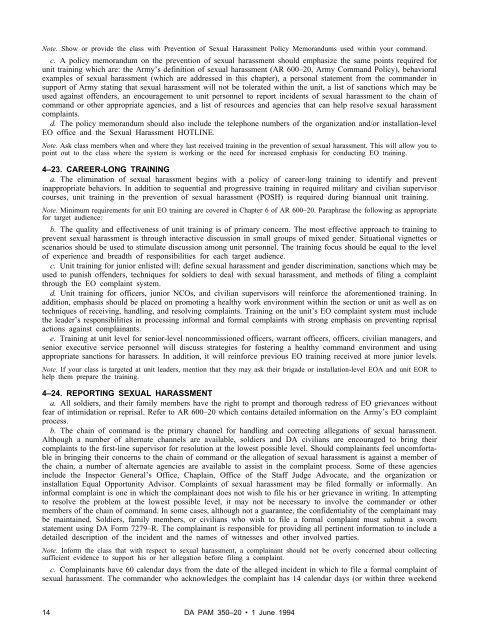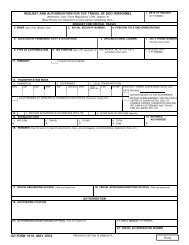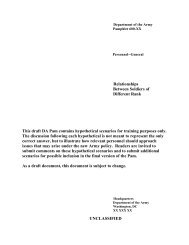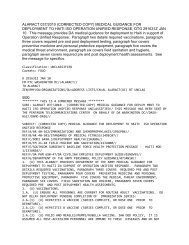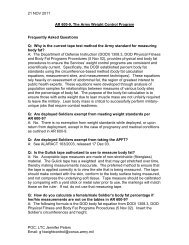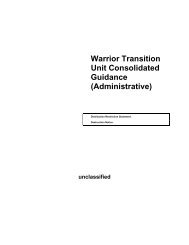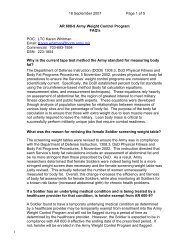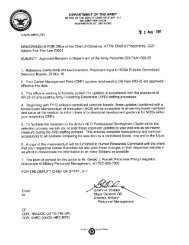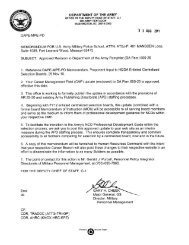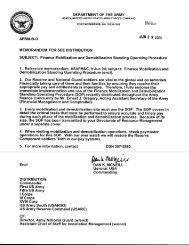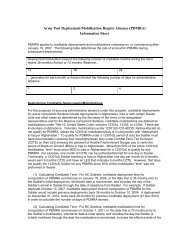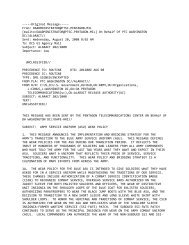Unit Equal Opportunity Training Guide - Deputy Chief of Staff ARMY ...
Unit Equal Opportunity Training Guide - Deputy Chief of Staff ARMY ...
Unit Equal Opportunity Training Guide - Deputy Chief of Staff ARMY ...
You also want an ePaper? Increase the reach of your titles
YUMPU automatically turns print PDFs into web optimized ePapers that Google loves.
Note. Show or provide the class with Prevention <strong>of</strong> Sexual Harassment Policy Memorandums used within your command.<br />
c. A policy memorandum on the prevention <strong>of</strong> sexual harassment should emphasize the same points required for<br />
unit training which are: the Army’s definition <strong>of</strong> sexual harassment (AR 600–20, Army Command Policy), behavioral<br />
examples <strong>of</strong> sexual harassment (which are addressed in this chapter), a personal statement from the commander in<br />
support <strong>of</strong> Army stating that sexual harassment will not be tolerated within the unit, a list <strong>of</strong> sanctions which may be<br />
used against <strong>of</strong>fenders, an encouragement to unit personnel to report incidents <strong>of</strong> sexual harassment to the chain <strong>of</strong><br />
command or other appropriate agencies, and a list <strong>of</strong> resources and agencies that can help resolve sexual harassment<br />
complaints.<br />
d. The policy memorandum should also include the telephone numbers <strong>of</strong> the organization and/or installation-level<br />
EO <strong>of</strong>fice and the Sexual Harassment HOTLINE.<br />
Note. Ask class members when and where they last received training in the prevention <strong>of</strong> sexual harassment. This will allow you to<br />
point out to the class where the system is working or the need for increased emphasis for conducting EO training.<br />
4–23. CAREER-LONG TRAINING<br />
a. The elimination <strong>of</strong> sexual harassment begins with a policy <strong>of</strong> career-long training to identify and prevent<br />
inappropriate behaviors. In addition to sequential and progressive training in required military and civilian supervisor<br />
courses, unit training in the prevention <strong>of</strong> sexual harassment (POSH) is required during biannual unit training.<br />
Note. Minimum requirements for unit EO training are covered in Chapter 6 <strong>of</strong> AR 600–20. Paraphrase the following as appropriate<br />
for target audience:<br />
b. The quality and effectiveness <strong>of</strong> unit training is <strong>of</strong> primary concern. The most effective approach to training to<br />
prevent sexual harassment is through interactive discussion in small groups <strong>of</strong> mixed gender. Situational vignettes or<br />
scenarios should be used to stimulate discussion among unit personnel. The training focus should be equal to the level<br />
<strong>of</strong> experience and breadth <strong>of</strong> responsibilities for each target audience.<br />
c. <strong>Unit</strong> training for junior enlisted will: define sexual harassment and gender discrimination, sanctions which may be<br />
used to punish <strong>of</strong>fenders, techniques for soldiers to deal with sexual harassment, and methods <strong>of</strong> filing a complaint<br />
through the EO complaint system.<br />
d. <strong>Unit</strong> training for <strong>of</strong>ficers, junior NCOs, and civilian supervisors will reinforce the aforementioned training. In<br />
addition, emphasis should be placed on promoting a healthy work environment within the section or unit as well as on<br />
techniques <strong>of</strong> receiving, handling, and resolving complaints. <strong>Training</strong> on the unit’s EO complaint system must include<br />
the leader’s responsibilities in processing informal and formal complaints with strong emphasis on preventing reprisal<br />
actions against complainants.<br />
e. <strong>Training</strong> at unit level for senior-level noncommissioned <strong>of</strong>ficers, warrant <strong>of</strong>ficers, <strong>of</strong>ficers, civilian managers, and<br />
senior executive service personnel will discuss strategies for fostering a healthy command environment and using<br />
appropriate sanctions for harassers. In addition, it will reinforce previous EO training received at more junior levels.<br />
Note. If your class is targeted at unit leaders, mention that they may ask their brigade or installation-level EOA and unit EOR to<br />
help them prepare the training.<br />
4–24. REPORTING SEXUAL HARASSMENT<br />
a. All soldiers, and their family members have the right to prompt and thorough redress <strong>of</strong> EO grievances without<br />
fear <strong>of</strong> intimidation or reprisal. Refer to AR 600–20 which contains detailed information on the Army’s EO complaint<br />
process.<br />
b. The chain <strong>of</strong> command is the primary channel for handling and correcting allegations <strong>of</strong> sexual harassment.<br />
Although a number <strong>of</strong> alternate channels are available, soldiers and DA civilians are encouraged to bring their<br />
complaints to the first-line supervisor for resolution at the lowest possible level. Should complainants feel uncomfortable<br />
in bringing their concerns to the chain <strong>of</strong> command or the allegation <strong>of</strong> sexual harassment is against a member <strong>of</strong><br />
the chain, a number <strong>of</strong> alternate agencies are available to assist in the complaint process. Some <strong>of</strong> these agencies<br />
include the Inspector General’s Office, Chaplain, Office <strong>of</strong> the <strong>Staff</strong> Judge Advocate, and the organization or<br />
installation <strong>Equal</strong> <strong>Opportunity</strong> Advisor. Complaints <strong>of</strong> sexual harassment may be filed formally or informally. An<br />
informal complaint is one in which the complainant does not wish to file his or her grievance in writing. In attempting<br />
to resolve the problem at the lowest possible level, it may not be necessary to involve the commander or other<br />
members <strong>of</strong> the chain <strong>of</strong> command. In some cases, although not a guarantee, the confidentiality <strong>of</strong> the complainant may<br />
be maintained. Soldiers, family members, or civilians who wish to file a formal complaint must submit a sworn<br />
statement using DA Form 7279–R. The complainant is responsible for providing all pertinent information to include a<br />
detailed description <strong>of</strong> the incident and the names <strong>of</strong> witnesses and other involved parties.<br />
Note. Inform the class that with respect to sexual harassment, a complainant should not be overly concerned about collecting<br />
sufficient evidence to support his or her allegation before filing a complaint.<br />
c. Complainants have 60 calendar days from the date <strong>of</strong> the alleged incident in which to file a formal complaint <strong>of</strong><br />
sexual harassment. The commander who acknowledges the complaint has 14 calendar days (or within three weekend<br />
14 DA PAM 350–20 1 June 1994


